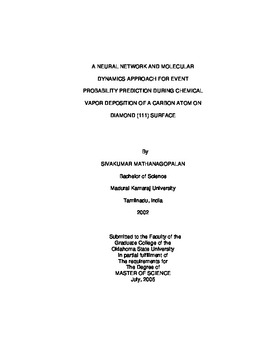| dc.contributor.advisor | Komanduri, Ranga | |
| dc.contributor.author | Mathanagopalan, Sivakumar | |
| dc.date.accessioned | 2014-04-17T19:53:10Z | |
| dc.date.available | 2014-04-17T19:53:10Z | |
| dc.date.issued | 2005-07-01 | |
| dc.identifier.uri | https://hdl.handle.net/11244/9992 | |
| dc.description.abstract | Diamond synthesized by chemical vapor deposition (CVD) has vast applications in electronic devices, cutting tools, sensors, and micro-electro-mechanical devices (MEMS) because of its outstanding mechanical properties. A few of them being high hardness, high wear resistance, high thermal conductivity and low compressibility. Carbon atoms form one of the primary growth species in the synthesis of diamond. Molecular dynamics (MD) simulation is a tool used to study this growth mechanism at the atomic scale. However, MD simulations are time consuming and are bound to have statistical errors. In this study, molecular dynamics (MD) simulation was used to investigate the event probabilities of chemisorption, scattering, and desorption that occur when a carbon atom reacts with a hydrogenated diamond (111) surface at a radical site. The probabilities were calculated from 50 MD simulation trajectories. The input conditions namely, incident angle, rotation angle, impact parameter , and kinetic energy of carbon atom were selected from distribution functions. The inputs and the outputs from MD simulations were then used to train multilayer neural networks (NN) to predict the aforesaid probabilities. To predict each of the three probabilities, 50 NN were trained. The probabilities obtained were the average of 50 neural networks. It was found that the NN predictions lie within one sigma standard deviation limit of MD. Also, the outputs of the neural networks were found to have less statistical fluctuation than MD. The NN were also advantageous in studying the effect of any input parameter on the other, in minutes as compared to a number of days by MD. It was also found that, as impact parameter increases, chemisorption and desorption probabilities decrease whereas the scattering probability increases. As incident angle increases, chemisorption probability and desorption probabilities decrease, whereas scattering probability increases. As kinetic energy of the carbon atom increases, chemisorption probability increases, whereas scattering and desorption probabilities decrease. As rotational angle increases, there seems to be no effect on any of the three probabilities. | |
| dc.format | application/pdf | |
| dc.language | en_US | |
| dc.publisher | Oklahoma State University | |
| dc.rights | Copyright is held by the author who has granted the Oklahoma State University Library the non-exclusive right to share this material in its institutional repository. Contact Digital Library Services at lib-dls@okstate.edu or 405-744-9161 for the permission policy on the use, reproduction or distribution of this material. | |
| dc.title | Neural Network and Molecular Dynamics Approach for Event Probability Prediction During Chemical Vapor Deposition of a Carbon Atom on a Diamond (111) Surface | |
| dc.type | text | |
| dc.contributor.committeeMember | Raff, Lionel Mischa | |
| dc.contributor.committeeMember | Hagan, Martin T. | |
| dc.contributor.committeeMember | Lu, Hongbin | |
| osu.filename | Mathanagopalan_okstate_0664M_1390.pdf | |
| osu.college | Engineering, Architecture, and Technology | |
| osu.accesstype | Open Access | |
| dc.description.department | Mechanical & Aerospace Engineering | |
| dc.type.genre | Thesis | |
